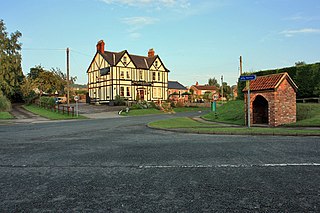
Caistor is a town and civil parish in the West Lindsey district of Lincolnshire, England. As its name implies, it was originally a Roman castrum or fortress. It lies at the north-west edge of the Lincolnshire Wolds, on the Viking Way, and just off the A46 between Lincoln and Grimsby, at the A46, A1084, A1173 and B1225 junction. It has a population of 2,601. Its name comes from the Anglo-Saxon ceaster and was given in the Domesday Book as Castre.

Howell is a hamlet in the North Kesteven district of Lincolnshire, approximately 1 mile (1.6 km) north of the A17, 4 miles (6 km) east from Sleaford, and 1.5 miles (2.4 km) north from Heckington. It is in the civil parish of Asgarby and Howell.

Hullavington is a village and civil parish in Wiltshire, England, just to the north of the M4 motorway. The village lies about 4 miles (6 km) southwest of Malmesbury and 5+1⁄2 miles (9 km) north of Chippenham.

Hemswell is a village and civil parish in the West Lindsey district of Lincolnshire, England. It is situated just north of the A631 on the Lincoln Cliff escarpment, 2 miles (3 km) west from Caenby Corner and 7 miles (11 km) east from Gainsborough. According to the 2001 Census it had a population of 309.

Heighington is a village and civil parish in the North Kesteven district of Lincolnshire, England. It is situated about 4 miles (6 km) south-east from the city and county town of Lincoln.

Bessingby is a village in the East Riding of Yorkshire, England. It lies immediately south-east from the A614, approximately 1.5 miles (2.4 km) south-west from Bridlington. The village forms part of Bridlington civil parish.

Holton-le-Clay is a village, civil parish and electoral ward in the East Lindsey district of Lincolnshire, England, around 5 miles (8.0 km) south of Grimsby. The village is twinned with Sargé-lès-le-Mans, Sarthe, France.

Horbling is a village and civil parish in the South Kesteven district of Lincolnshire, England. It lies on the B1177, 7 miles (11 km) south-east of Sleaford, 14.5 miles (23 km) north-east of Grantham and 0.5 miles (0.8 km) north of Billingborough.

Legsby is a small village and civil parish in the West Lindsey district of Lincolnshire, England. The population of the civil parish at the 2011 census was 193. It is situated approximately 13 miles (20 km) north-east from the city and county town of Lincoln and 3 miles (5 km) south-east from the town of Market Rasen.

Scagglethorpe is a village and civil parish in the Ryedale district of North Yorkshire, England. Until 1974 the village lay in the historic county boundaries of the East Riding of Yorkshire. It is situated just south from the A64 road, 3 miles (5 km) east from Malton and almost midway between York and Scarborough.

Haltham is a village and civil parish in the East Lindsey district of Lincolnshire, England. The population of the civil parish at the 2011 census was 122. It is situated 4 miles (6.4 km) south from the town of Horncastle, and on the east bank of the River Bain in the Lincolnshire Wolds, a designated Area of Outstanding Natural Beauty.

Doddington is a village in the civil parish of Doddington and Whisby in the North Kesteven district of Lincolnshire, England. The population of the civil parish at the 2011 census was 319. The parish lies 5 miles (8 km) west of Lincoln, to the north of the A46 road, and is bounded to its west by Nottinghamshire. It includes the hamlet of Whisby, and parts of the Whisby Moor Nature Reserve.

Gayton le Wold is a village and civil parish in the East Lindsey district of Lincolnshire, England. It lies 6 miles (10 km) west from Louth, 3 miles (5 km) north from Donington on Bain, and to the south of the A157. The parish includes Biscathorpe 1 mile (1.6 km) to the south-west.

Gautby is a village in the East Lindsey district of Lincolnshire, England. The village is situated 6 miles (10 km) north-west from the town of Horncastle, and is part of the Minting civil parish.

Haugh is a hamlet and civil parish in the East Lindsey district of Lincolnshire, England. It is situated about 2 miles (3 km) south-west from the town of Alford.

Waithe is a hamlet and civil parish in the East Lindsey district of Lincolnshire, England. It is on the A16, 1 mile (1.6 km) south from Holton-le-Clay and 1 mile (1.6 km) north from North Thoresby.

Fotherby is a village and civil parish in the East Lindsey district of Lincolnshire, England. It is situated just east from the A16 road, 13 miles (21 km) east from Market Rasen, and 10 miles (16 km) south from Cleethorpes.

Owmby is a hamlet in the civil parish of Searby cum Owmby, in the West Lindsey district of Lincolnshire, England. It is less than 1 mile (1.6 km) south from the A1084 road, 3 miles (5 km) north-west from Caistor, 4 miles (6 km) south-east from Brigg, and in the Lincolnshire Wolds, a designated Area of Outstanding Natural Beauty. The parish village of Searby is less than 1 mile to the north-east.

Thornton le Moor is a village in the civil parish of Owersby in the West Lindsey district of Lincolnshire, England, situated approximately 5 miles (8 km) south-west from the town of Caistor. Between 1866 and 1936 Thornton le Moor was a separate civil parish.

The Moot Hall is a civic building in Market Rasen Road, Holton le Moor, Lincolnshire, England. The building, which continues to be used for civic meetings, was built in 1910.





















